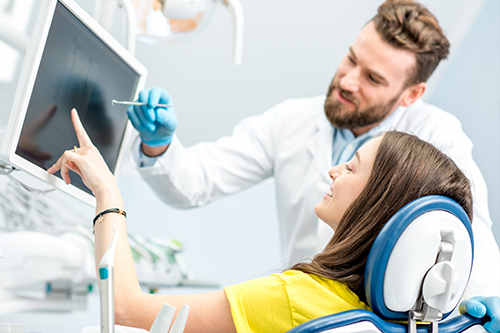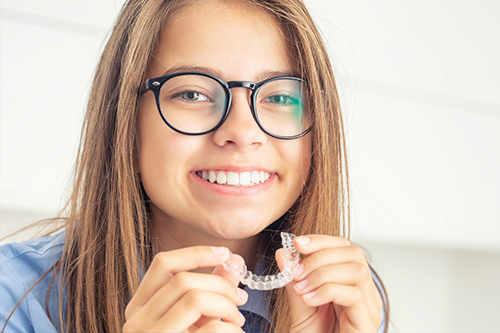
Invisalign® offers a discreet, modern alternative to traditional braces. Designed from clear, custom-made thermoplastic, these aligners move teeth gently and predictably while letting you keep your everyday routines intact. For many adults and teens, the appeal is simple: effective orthodontic care without the visual and lifestyle compromises that come with wires and brackets.
Clear aligners blend into your life rather than interrupting it. Because they are virtually transparent, most people notice subtle changes in alignment long before others do. That discretion can be especially valuable for professionals, students, or anyone who prefers a low-profile approach to orthodontic improvement.
Beyond appearance, aligners improve the day-to-day experience of orthodontic treatment. They are removable for eating and cleaning, which makes maintaining oral hygiene simpler than with fixed appliances. This removability also reduces the need for dietary modifications and helps minimize the risk of staining or plaque buildup associated with brackets.
At Brilliant Dental of Salem, we emphasize predictable planning and patient comfort. Invisalign® uses a system of staged aligners so tooth movement is incremental and controlled, and each step is based on an individualized map developed from detailed imaging of your mouth.
Modern aligner therapy starts with a precise digital scan or impression of your teeth. These high-resolution records let your dentist visualize current alignment, evaluate bite relationships, and identify the specific movements needed to reach your goals. The information is used to create a step-by-step treatment roadmap that anticipates how each tooth will shift over time.
From there, a computerized model generates a series of custom aligners. Each aligner represents a progressive stage in the plan, applying light, targeted forces to guide teeth toward the desired positions. This controlled, incremental approach helps minimize discomfort and keeps progress steady and measurable.
The planning stage is also an opportunity to address functional concerns—such as bite discrepancies or uneven wear—alongside cosmetic goals. Your dentist will balance esthetic outcomes with long-term oral health so that the final smile is not only straighter, but also better integrated with the way your jaws meet and function.
Once your custom plan is finalized, treatment proceeds through a sequence of aligners you replace at regular intervals. Each new aligner advances the plan a little further, producing gradual, consistent progress. Periodic check-ins allow your dentist to monitor movement and make adjustments when necessary to keep the treatment on track.
Many patients appreciate the predictable rhythm of aligner treatment: the sense of visible progress with minimal disruption to daily life. Check-ups tend to be straightforward and focused on verifying fit and tracking alignment—there are no wires to tighten or brackets to repair.
Because every smile is unique, the exact length of treatment varies. Your care team will provide an individualized timeline based on the complexity of your case and the objectives established during planning.

Your consultation begins with an exam and a discussion of your smile goals. We assess your oral health, review imaging, and outline whether aligner therapy aligns with your needs.

Using 3-D visualization, we can show the projected progression of your smile. This preview helps you and your dentist confirm objectives before production of the aligners begins.

Aligners are fabricated to match the precise contours of your teeth and gums. They are designed for comfort and repeatability so that each staged appliance advances treatment consistently.

From your first set of aligners through the finishing stages, your dentist provides guidance, monitors progress, and adjusts the plan when needed to achieve durable results.
Success with aligners depends on consistent wear and proper care. Aligners should be worn for the majority of the day and removed only for eating, drinking anything other than water, and oral hygiene. Because they are removable, you retain full access to regular brushing and flossing—an important advantage for maintaining gum health during treatment.
Cleaning aligners is straightforward: rinsing after removal and gently brushing them helps prevent odor and buildup. Avoid hot water and abrasive cleaners that can distort the plastic. Storing aligners in their case when not in use reduces the risk of loss or damage.
If an aligner feels tight or causes minor soreness when you switch to a new set, that usually indicates it is doing its job. Persistent pain, significant fit issues, or damage to an aligner should prompt a call to your care team so they can assess and support your progress.
Clear aligner therapy is a partnership between you and your dental provider. Regular appointments let your dentist confirm the plan is progressing as intended and intervene if refinements are needed. These reviews ensure that the final outcome is stable and aligned with your expectations for both appearance and function.
Once active movement is complete, retention is a common next step to preserve the new positions of your teeth. Your dentist will discuss options for retainers or other strategies to help maintain results over time. Long-term stability is a primary objective of every treatment plan.
Throughout the process, education and support are central. Your care team will walk you through each stage, answer questions about hygiene and comfort, and provide practical tips to make the experience as smooth as possible.
Explore videos and demonstrations that explain how aligner therapy works, what to expect during treatment, and best practices for aligner care.
These materials are intended to supplement your consultation and give you a clearer sense of the clinical steps behind a predictable, modern orthodontic approach.
*Invisalign® is a registered trademark of Align Technology, Inc.
In summary, Invisalign® offers a precise, flexible method for aligning teeth that emphasizes comfort, discretion, and predictable planning. If you'd like to learn whether this approach is a fit for your smile, please contact us for more information and to schedule a consultation.

Invisalign® is a modern orthodontic system that uses a series of clear, custom-made thermoplastic aligners to move teeth incrementally. Each aligner is worn for a prescribed period to apply gentle, targeted forces that guide teeth toward their planned positions. The appliances are removable, so oral hygiene and eating routines remain largely unchanged.
Treatment is driven by a digitally created plan that maps each stage of tooth movement from the initial position to the desired outcome. Aligners are produced to the precise contours of your teeth so changes occur predictably and with minimal interruption to daily life. This combination of digital planning and staged aligners is what distinguishes Invisalign from traditional fixed appliances.
Many adults and teens with mild to moderate alignment issues are excellent candidates for Invisalign®. The system can address crowding, spacing, and certain bite concerns, though complex skeletal problems may still require traditional orthodontic approaches. A clinical evaluation and digital scan are required to determine whether aligner therapy can meet both your cosmetic and functional goals.
Suitability depends on oral health as well — untreated decay, active gum disease, or missing teeth can affect the plan and should be treated before starting. Compliance is also a factor because aligners must be worn consistently to achieve the planned movements. Your dentist will review medical and dental history, take images, and discuss realistic expectations during the consultation.
Treatment begins with a high-resolution digital scan or impression of your teeth, which creates a 3-D model for precise diagnosis and planning. Specialized software simulates the tooth-by-tooth movements and generates a step-by-step treatment roadmap used to fabricate the aligners. This digital workflow allows the dentist to preview expected results and make adjustments before aligner production.
The aligners themselves are manufactured from medical-grade thermoplastic to match the planned stages exactly, reducing variability in fit and force application. In-office tools such as intraoral scanners and radiographs help assess bite relationships and functional considerations alongside cosmetic objectives. Regular monitoring ensures the digital plan remains accurate as treatment progresses.
After planning and fabrication, treatment proceeds through a series of sequential aligners that you replace according to your dentist's schedule, usually every one to two weeks. Each new aligner advances the treatment slightly so that changes accumulate steadily over time. Periodic appointments allow the dentist to verify fit and make refinements if needed.
Treatment length varies with the complexity of the case, commonly ranging from several months to over a year for more involved movements. Factors such as patient compliance, initial alignment, and the extent of bite correction influence the timeline. Your care team will give a personalized estimate and update the schedule as progress is reviewed.
Proper care extends the life of your aligners and keeps them hygienic; rinse them each time you remove them and brush gently with a soft toothbrush using lukewarm water. Avoid hot water, abrasive toothpaste, or household cleaners that can warp or scratch the plastic. When not in use, always store aligners in their protective case to prevent damage or loss.
Maintain your regular oral hygiene routine by brushing and flossing before reinserting aligners to reduce the risk of staining and plaque buildup. If an aligner develops a persistent odor or discoloration, inform your dentist so they can advise on cleaning options or replacements. Follow any additional cleaning instructions provided by your care team to preserve fit and comfort.
Because aligners are removable, most people can continue to eat their regular diet without the restrictions typical of fixed braces. You remove the aligners to eat and drink anything other than water, then brush prior to reinserting them to protect enamel and aligner hygiene. This flexibility simplifies social and professional situations where appearance or comfort is a concern.
Speech may be slightly altered for a short time when you first begin wearing a new aligner, but most patients adapt within a few days as the mouth adjusts. Aligners are virtually transparent, allowing for a less noticeable appearance during treatment compared with metal brackets and wires. If you have questions about specific activities such as playing wind instruments or sports, your dentist can recommend temporary adjustments or protective options.
Check-ins are typically brief and focus on fit, progress, and any concerns about comfort or oral health. Your dentist will assess whether teeth are tracking according to the digital plan and determine if refinements or additional aligners are required. These visits are also opportunities to address hygiene, monitor gum health, and review proper wear instructions.
If teeth are not moving as expected, the care team may order refinements or modify the sequence to regain predictable progress. Attachments—small composite bumps bonded to teeth—may be placed or adjusted to assist certain movements, and these are removed after treatment. Clear communication with your provider ensures any necessary changes are implemented promptly to protect outcomes.
Mild soreness or pressure is common when moving to a new aligner because the appliance is applying force to shift teeth. Over-the-counter pain relievers, short-term use of cold packs, and soft foods for a day or two can help manage discomfort while teeth acclimate. Most patients describe the sensation as tolerable and brief given the incremental nature of the movements.
If an aligner causes persistent sharp pain, rubbing, or sore spots on soft tissues, contact your dental team for evaluation and adjustment. They can check the fit, trim irritating edges, or provide guidance on easing specific pressure points. Prompt attention prevents small issues from becoming obstacles to progress.
Retention is the next phase after active movement to maintain teeth in their new positions and reduce the likelihood of relapse. Your dentist will recommend a retainer protocol tailored to your case, which may include clear removable retainers or fixed bonded retainers for longer-term stability. Wearing retainers as instructed is the primary determinant of how long results last.
Follow-up visits allow the dentist to evaluate stability and adjust retention plans if minor settling occurs. Good oral hygiene and periodic dental exams support long-term outcomes by addressing changes that could influence tooth position over time. The goal of retention is to preserve both the cosmetic and functional improvements achieved through treatment.
To explore whether Invisalign® suits your needs, schedule an evaluation with our team where we review your oral health, take digital images, and discuss your smile goals. During the consultation we will explain the process, show a projected treatment preview when possible, and outline any preparatory care needed before starting therapy. This visit is an opportunity to ask specific questions about comfort, timeline, and functional objectives.
Brilliant Dental of Salem emphasizes individualized planning and patient comfort throughout treatment, and we coordinate follow-up care to support predictable outcomes. If you decide to proceed, the digital records collected at the consultation will be used to build your customized treatment roadmap. Contact the office to arrange a consultation and receive guidance tailored to your smile.

Ready to schedule your next dental appointment or have questions about our services?
Contacting Brilliant Dental of Salem is easy! Our friendly staff is available to assist you with scheduling appointments, answering inquiries about treatment options, and addressing any concerns you may have. Whether you prefer to give us a call, or fill out our convenient online contact form, we're here to help. Don't wait to take the first step towards achieving the smile of your dreams – reach out to us today and discover the difference personalized dental care can make.